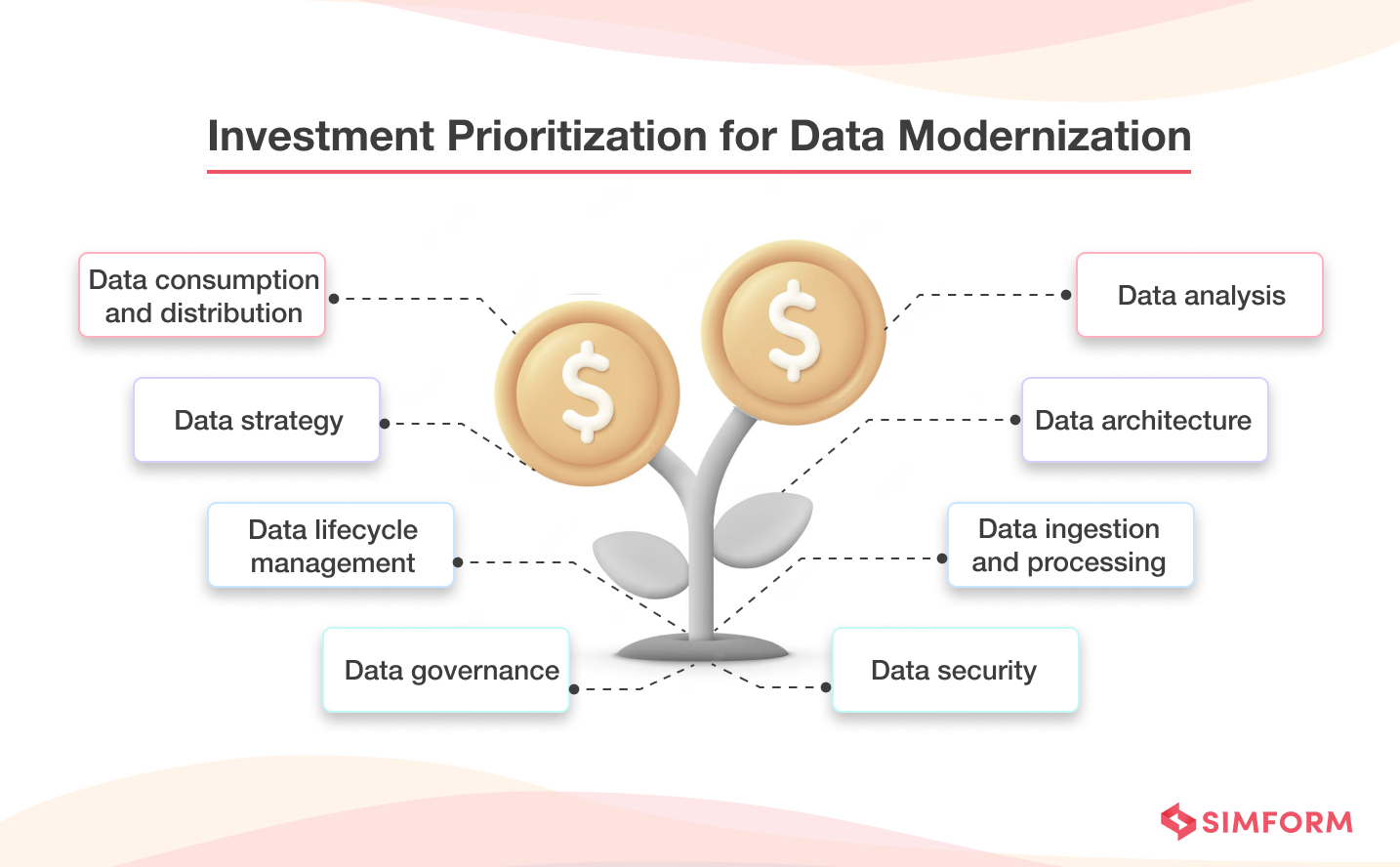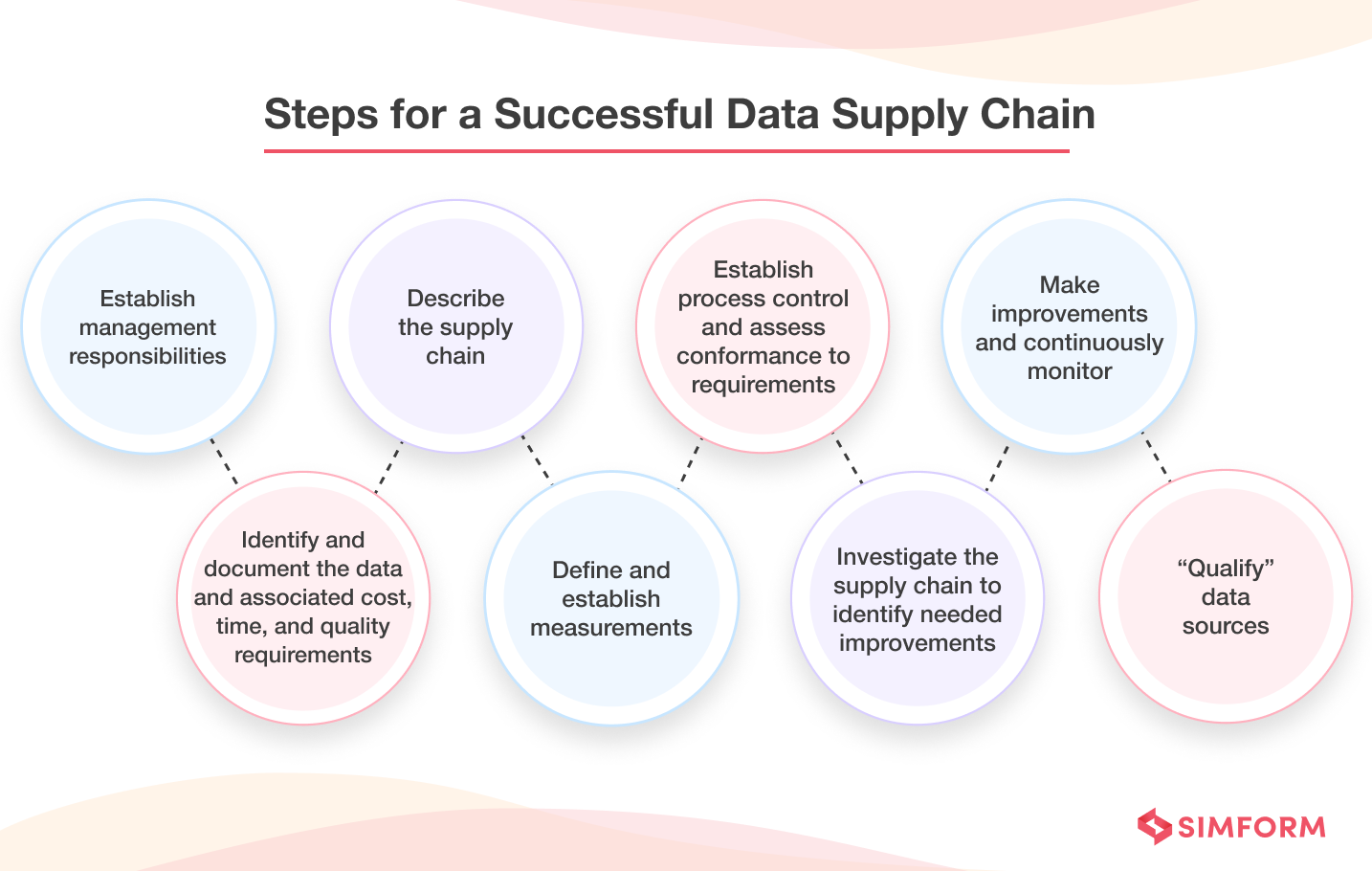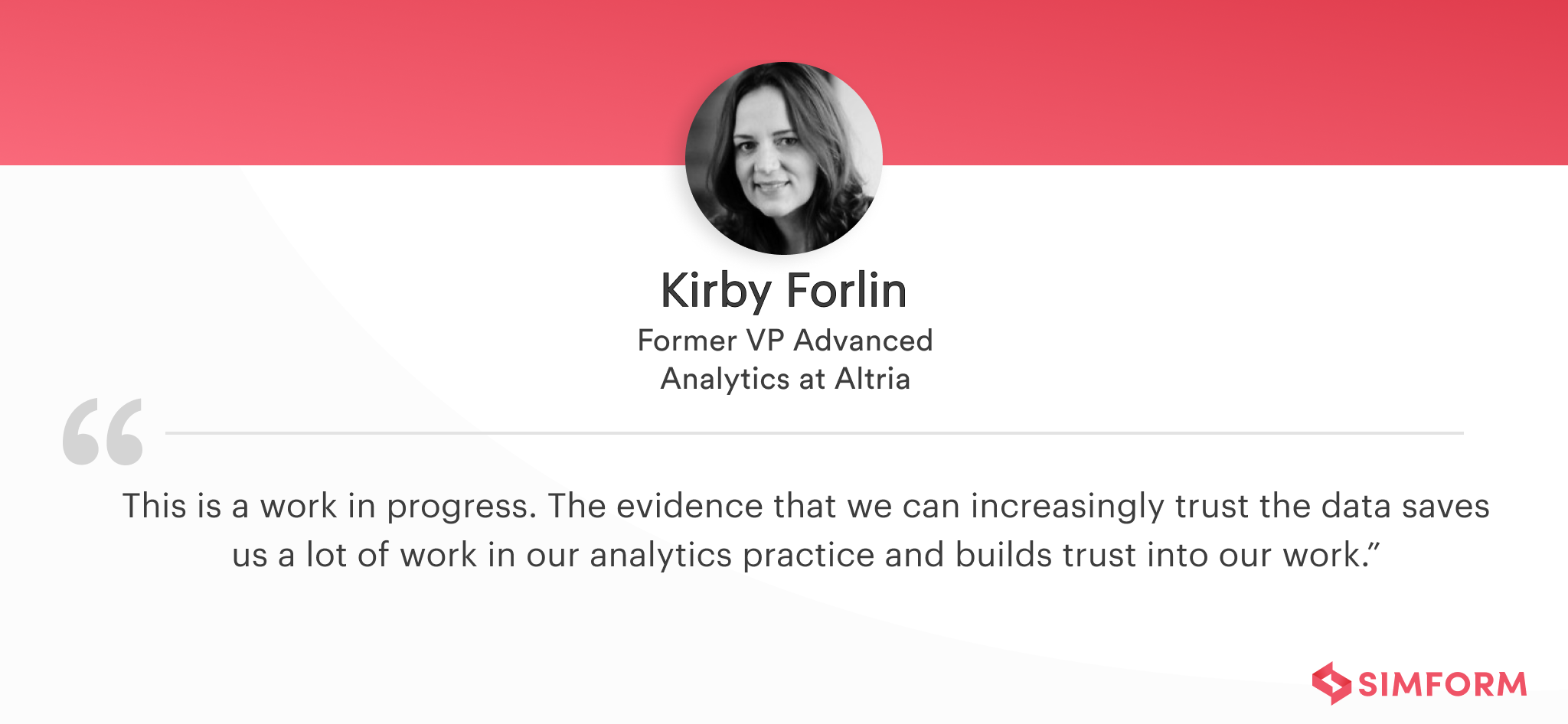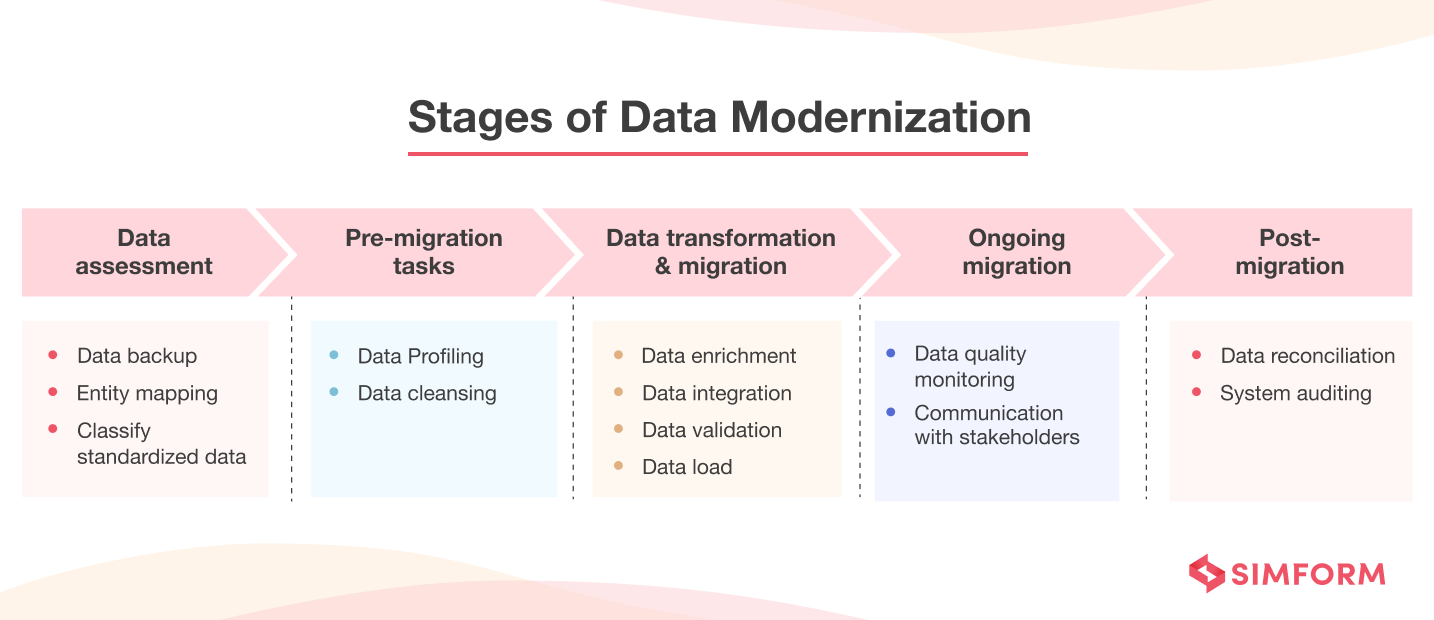IDC predicted the amount of digital data generated to grow to 175 ZB by 2025. This isn’t much surprising, seeing the technology sitting at the heart of every modern enterprise. However, IT organizations stuck with the legacy system, using outdated technology, cannot properly utilize the unlimited data they generate. According to a survey, only 32% of companies can realize tangible and measurable value from data.
Data modernization is key for organizations to pivot wisely and close the gap between the value their existing structures capture and the value that new technologies make possible.
With the seamless data movement among various databases, enterprises can improve data consolidation, break silos, and make data ready for analytics.
Read the article to learn more about how to address the challenges of legacy data management systems and create data solutions that are scalable, agile, real-time, high-speed, and future-ready.
Now, let’s take the first step towards understanding how to manage, process, and derive value from your data.
What is data modernization?
Data modernization encompasses a wide range of activities essential to ensure data accuracy, reliability, compliance, and security. The activities involved in this multifaceted process can include:
- Establishing processes and systems for managing large volumes of data
- Migrating legacy systems to newer platforms such as cloud databases
- Developing a comprehensive data governance strategy
- Embracing modern data methods to leverage the advantages of artificial intelligence and machine learning
- Investing in analytics tools to uncover valuable insights from user behavior
Additionally, businesses must implement security measures such as encryption and access control mechanisms to ensure data security during and after modernization.
What role does the cloud play?
As the cloud is both a means to and an important consequence of data modernization, cloud migration and data modernization normally go hand in hand.
Cloud is already a preferred location for data storage, with 57% of businesses having their important applications and data on it. That’s saying a lot since many organizations, like financial, healthcare, government, etc., need to keep some critical applications and data on the premises for regulatory and security reasons.
So yes, it’s possible to pursue only on-premise modernization projects that involve optimizing infrastructure, updating hardware and software, and implementing new technologies. However, many companies prefer migration to achieve scalability, improved disaster recovery capabilities, and cost-efficiency.
Generally, cloud providers are quite capable in data management with a wide range of data management tools and services in their arsenal, including relational data warehouses, a wide range of external data sources, and high-quality algorithms for analytics and AI.
What are the benefits of data modernization?
According to the Deloitte survey, 84% of organizations have initiated their journeys toward data modernization, with 34% claiming to have fully implemented it. Several reasons, such as the need for storing unstructured data like images, social media comments, customer voice audio, and clinical notes in healthcare, demand the data be modernized.
Financial services firms are the most likely to have initiated data modernization, while technology, media, and telecom companies have a unique opportunity to embrace the possibilities and lead the way in their industry. Here’s what you get by unlocking the true potential of your data with modernization.
1. Better business intelligence with data warehousing
By consolidating data from different systems and departments, a data warehouse allows for a more complete and accurate view of the organization’s performance and operations.
Let’s understand this with a hypothetical example. Suppose, RetailCo is a large retail chain with stores across the country. They implement a data warehouse to improve their business intelligence by consolidating, cleaning, and integrating data from their different POS systems. This allows them to gain reliable insights into their inventory levels, sales performance, and customer behavior.
2. Flexibility, scalability, and security with the cloud
The credit for handling all that data and accommodating the benefits of modernization can be given to cloud services. They can scale storage and computing resources up or down as needed, allowing for flexible and adaptable data management. This flexibility also means that you can access your data from anywhere, from any device, and at any time.
Organizations can benefit from built-in security measures such as authentication, access control, encryption, and data protection by migrating to the cloud.
3. Quality database & compliance with data governance
When you establish procedures, policies, and standards for managing and protecting data and monitoring data quality metrics, your data’s accuracy significantly improves, leading to better decision-making. Also, you can further stay compliant with GDPR, HIPAA, PCI DSS, FERPA, CCPA, and any other relevant regulation.
With improved data quality, you can build adaptable and scalable processes that help reduce costs and boost margins.
4. Personalized user experiences with AI and ML
The real-time and predictive insights provided by AI/ML help businesses understand their customers better. We’re no more surprised by Netflix always seeming to know exactly what show or movie we’ll love next! All thanks to AI and ML data analytics, which allow them to keep track of their user’s viewing history and preferences. And Amazon is also doing the same by analyzing the users’ purchase history and browsing behavior.
AI/ML also enhances the capacity to create new, better, and more efficient business models, providing a competitive advantage to a business.
What are the challenges to data modernization?
Modernizing data estates and environments can be difficult, needing a lot of heavy lifting. There can be a number of challenges on the way –
1. Managing the complexity of large amounts of data
Streaming, embedded use cases, advanced analytics, real-time, near real-time, and bi-directional use cases are becoming common for organizations, even when they are less mature in the data analytics lifecycle. Large, diverse sets of information make it difficult to ensure the data’s accuracy, comprehensiveness, and consistency.
2. Identifying the most useful data for particular business goals
Sheer volume of data can lead to data overload, negatively impacting decision-making. Structured, semi-structured, and unstructured data may require different methods for analysis. Additionally, data collected from a variety of sources like social media, internal systems, and external partners make it difficult to integrate and analyze.
3. Determining the best way to store and analyze data
It can be difficult finding the right technology stack and storage and analysis solutions with the ability to handle the exponential data volumes while maintaining acceptable performance levels.
4. Integrating new systems with legacy ones
New systems may use different data formats, leading to data mapping and translation issues and even potential data loss when the data is not properly converted.
5. Ensuring data security and compliance
Migrated or consolidated data can become fragmented across multiple locations and systems, making it difficult to manage access control and detect and respond to security incidents. Then, integrating new systems with third-party systems may introduce additional security and compliance issues.
6. Minimizing disruptions to business operations
With inefficient planning, cloud migration may cause downtime for critical applications and systems, resulting in loss of productivity and revenue. Also, the data might get corrupted or lost during the process, leading to a negative impact on the organization’s bottom line and poor decision-making.
How can enterprises have a perfect application modernization strategy?
So, to tackle these challenges regarding complexity, data loss/corruption, security, cost, and limited flexibility, you need to know the stages involved and develop a comprehensive data modernization strategy.
What are the stages of effective data modernization?
The journey to updating an organization’s data infrastructure can be divided into five critical stages, each built upon the previous one. Let’s explore how these stages help ensure that the organization’s data assets are utilized to their full potential.
1. Data assessment
The first step should be to take a data backup to recover it in case of unforeseen circumstances. The next step should include gaining a comprehensive understanding of the existing data and its structure and identifying any issues or inaccuracies at the earliest.
With entity mapping, you can map source entity attributes to target entity attributes and identify unmapped attributes, which may result in data loss. Accordingly, you can develop a migration strategy that includes
- Required staging storage/ hardware
- The downtime required due to migration
- Migration impact on target database size
- Tracking updates to source during migration
By following the proof of concepts defined in the strategy document, you can classify standardized data and analyze the ease of maintainability.
2. Pre-migration tasks
Now is the time to check on data inconsistency against predefined standards. Activities performed in this stage make your database ready for migration.
- With data profiling, you can create a detailed profile of your data, including data types, the number of records, and the distribution of values.
- Data entered with the wrong data type or incorrect format can cause problems while analyzing the data or performing calculations. You can apply a set of rules or algorithms to the data to identify and correct inconsistencies and errors. The data cleansing process can be automated or done manually based on the complexity of the errors or the size of the database.
3. Data transformation and migration
The removal of inconsistencies and duplicate records makes data reliable to be used for analysis and decision-making.
- Further, by performing data enrichment with data warehousing or data mining, you can add additional information like demographic information, geographic information, etc.
- Next comes data integration, the process of combining data from multiple sources(systems/applications/databases) into a single database. That’s how you can get a unified view of the data. The more useful the data, the more complete the picture you get to see and make informed decisions.
- Most of the data integration platforms include automated data validation, which is a type of data cleansing. This would help you confirm that the data integrated from various sources and repositories have not become corrupted because of inconsistencies in context or type.
- Now, the transformed data can be moved from one database system to another or from a legacy system to a modern database system. Data load can be performed using data import/export tools and other data management techniques.
4. Ongoing migration
Allocating and managing the resources, including personnel, technology, and budget, is a crucial aspect of continuous migration.
Then, the data quality needs to be monitored during the migration, and the errors found must be rectified to ensure that the data remains accurate, complete, and consistent. Even the progress of the migration process must be monitored to see that it is on track and all milestones are being met.
Meanwhile, the stakeholders must be informed about the progress of the migration and any issues that arise.
5. Post-migration
Once the data has been migrated, it’s important to compare the transformed data with the original data in the legacy system to ascertain the completeness, accuracy, and security of all the data. That’s data reconciliation, which can be performed with automated tools, manual checks, or a combination of both.
The process should comprise various types of tests, including unit tests, volume tests, web-based application tests, system tests, and batch application tests.
Further, the audit of the entire system and data quality should be conducted to ensure there was no error during the migration process. And, if any issues, such as missing or corrupted data, are identified, restoring these files from a backup taken at the beginning is essential.
4 Key practices for effective data modernization
As data is likely to be your organization’s most valuable asset (after the employees, of course), having a data-focused strategy is essential. Otherwise, your data might remain scattered across silos and legacy systems. Here are the best practices that will let you unlock trapped legacy data and capture the true value of data from the edge to the data center to the cloud.
1. Determine the perfect level of data-first maturity
The data-first maturity level of any organization can generally be categorized in a few ways, shown in the table:
| Level | Data collection, storage, and analysis capabilities | Decision-making |
| Initial | limited | Based on intuition and experience |
| Basic | Established processes | Basic data reporting and visualization tools |
| Structured | A formal data governance structure, established KPIs | Have tools for data analysis and reporting |
| Managed | Mature data management infrastructure, including data warehouses, data lakes, | Robust data analysis tools |
| Optimized | Fully integrated data into all aspects of their business, Have a culture that prioritizes data-driven decision-making | Advanced analytics techniques, such as machine learning and artificial intelligence |
Organizations may not necessarily advance through these maturity levels in a linear fashion and may have different levels in different areas of the business. The ideal level of data-first maturity depends on various factors, such as business goals and objectives, data infrastructure, data usage, organizational culture, and industry and regulatory landscape.
The goal should be to consistently strive for higher levels of data maturity that enable you to drive better business outcomes and remain competitive in a data-driven world.
2. Prioritize your investments
Based on your organization’s strengths and weaknesses, you can prioritize investments for certain subdomains of your organization, as shown in the image below.

Investment in these subdomains can be prioritized based on a number of factors, including strategic alignment, market demand, resource availability, risk and uncertainty, and potential impact. When these activities are prioritized in the best possible manner, you can make smart decisions based on timely and accurate data insights.
3. Industrialize your data supply chains
A data supply chain is a complicated system made up of technologies, processes, and people involved in creating, storing, processing, and disseminating data within an organization.
Shown in the image are the steps to follow for creating an efficient data supply chain.

Only a few organizations yet employ data supply chain management, but those that do certainly report better results. For example, Altria, the U.S.-based provider of tobacco and smoke-free products, uses a data supply chain to make informed decisions and optimize its business operations. The company faced difficulties collecting and integrating data from multiple sources, like suppliers, distributors, and retail customers. The result was siloed, inconsistent, and difficult to access data.
Starting somewhere in 2018, by concentrating on the most basic requirements first, Altria improved quality from 58% to 98% in three years. Later, their team started adding more advanced requirements to the mix.

4. Unify data in multiple, disparate operating models
Today’s organizations are likely to use containerized microservices distributed across clusters of servers. Even if you use virtual machines, your infrastructure will generally be highly distributed, and machine images might move between host servers.
This complexity makes it pretty challenging to manage and integrate different tools within your environment, more so when each tool uses its own data model.
A unified data model creates a single point of access for centralizing all the data combined from many heterogeneous data sources, including CRMs, BI analytical tools, ERPs, and supply chain management models. With all the data centralized in a data warehouse, data scientists can run analyses and define advanced machine-learning algorithms to optimize each scenario. This bridge between your different ecosystems will allow you to contextualize data sources across various services.
Some of the other standard practices for successful data modernization are:
- Selection of a suitable cloud migration platform
- Centralizing and certifying key business metrics and trusted reports
- Optimizing data lake environment (productivity and access)
- Investment in AI/ML for automated extraction of unstructured data, workflow automation, and predictive analytics
- Establishing a governance plan that consists of detailed policies on how data will be used, who owns, maintains, and accesses data
- Using cloud-native monitoring tools like New Relic, Amazon CloudWatch, Cloudyn, Informatica, etc., to monitor data and derive insights.
Build confidence in your data with modernization
As the cloud is a supporting and overlapping part of today’s data landscape, cloud migration, along with AI and big data analytics, has become non-negotiable in building an information-driven business culture. Simform’s data management and analysis experts help organizations that struggle with data latency, data explosion, and increasing data management costs.
One of our esteemed clients, SenTMap, wanted an efficient solution for ingesting data from thousands of news and broadcast channels and filtering the required information for end users. After analyzing all the requirements, our team built a scalable real-time analytics engine that could perform analysis based on real-time News Data. If you, too, need help addressing the challenges presented by the existing system, let’s build a modern data foundation with a holistic data strategy.
